Health Law: Analysis of Nursing Home Regulations and Practices
VerifiedAdded on 2022/11/23
|8
|1682
|274
Report
AI Summary
This report delves into various aspects of health law concerning nursing homes. It examines the importance of regulations, including resident rights, quality of care, and infection control. The report presents a case study involving a nursing home where unauthorized medical practices and potential negligence occurred, raising questions about legal liabilities and professional standards. It explores the legal ramifications of malpractice and negligence by healthcare professionals, including the implications of improper treatment and unauthorized medical interventions such as acupuncture. The analysis covers the responsibilities of nursing homes, the role of critical thinking in nursing practice, and the importance of adhering to established standards of care to ensure patient safety and well-being.
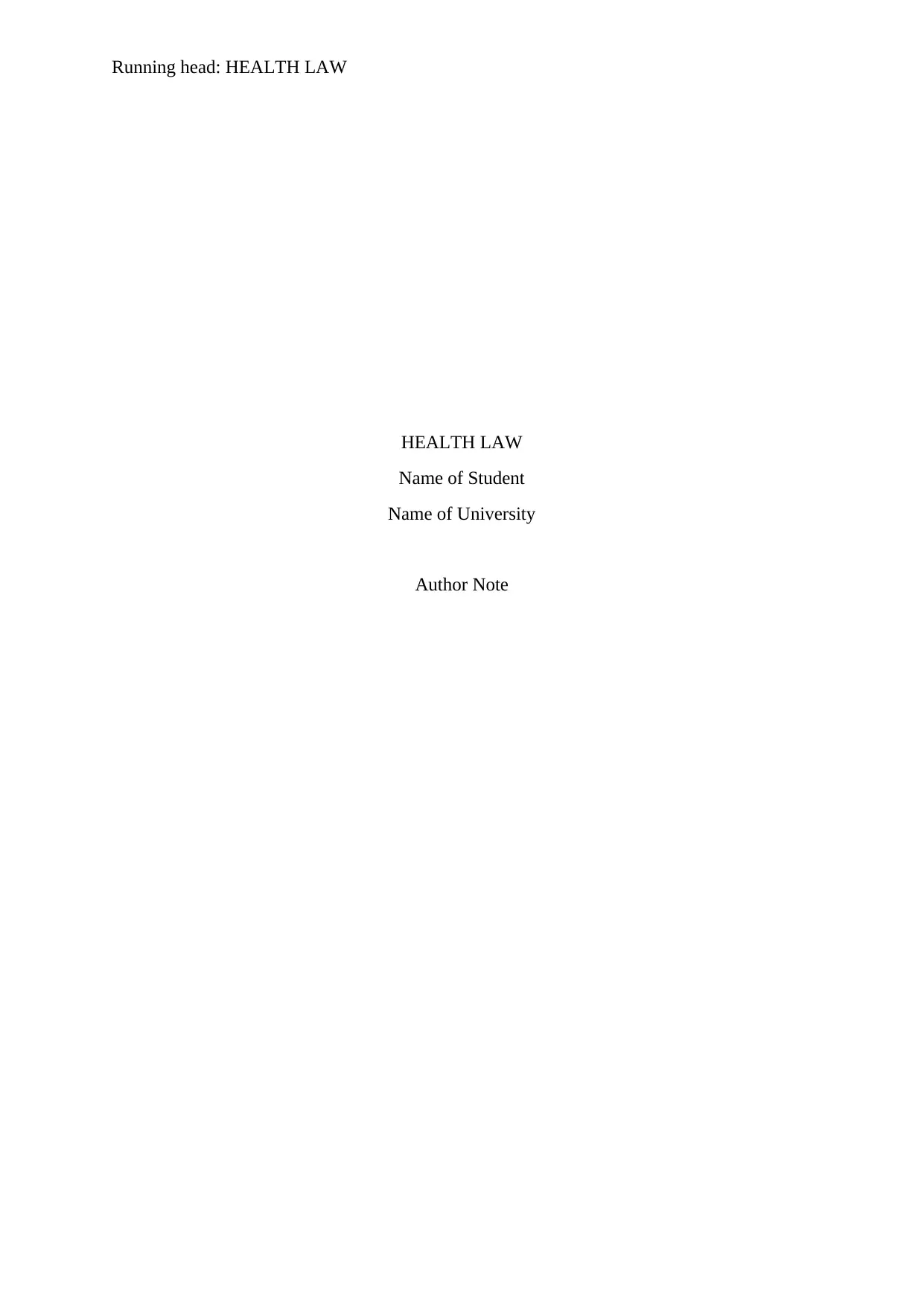
Running head: HEALTH LAW
HEALTH LAW
Name of Student
Name of University
Author Note
HEALTH LAW
Name of Student
Name of University
Author Note
Paraphrase This Document
Need a fresh take? Get an instant paraphrase of this document with our AI Paraphraser
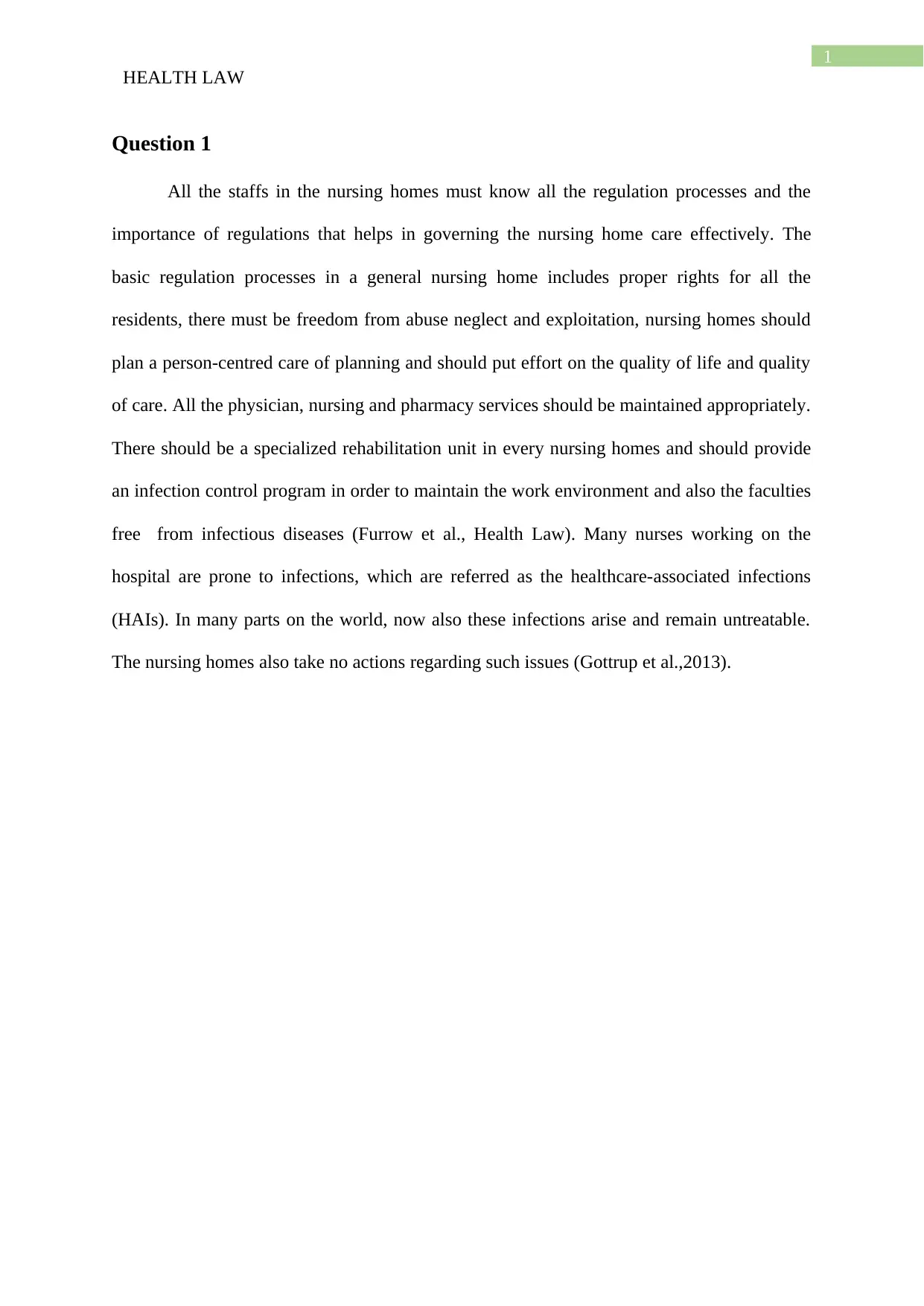
1
HEALTH LAW
Question 1
All the staffs in the nursing homes must know all the regulation processes and the
importance of regulations that helps in governing the nursing home care effectively. The
basic regulation processes in a general nursing home includes proper rights for all the
residents, there must be freedom from abuse neglect and exploitation, nursing homes should
plan a person-centred care of planning and should put effort on the quality of life and quality
of care. All the physician, nursing and pharmacy services should be maintained appropriately.
There should be a specialized rehabilitation unit in every nursing homes and should provide
an infection control program in order to maintain the work environment and also the faculties
free from infectious diseases (Furrow et al., Health Law). Many nurses working on the
hospital are prone to infections, which are referred as the healthcare-associated infections
(HAIs). In many parts on the world, now also these infections arise and remain untreatable.
The nursing homes also take no actions regarding such issues (Gottrup et al.,2013).
HEALTH LAW
Question 1
All the staffs in the nursing homes must know all the regulation processes and the
importance of regulations that helps in governing the nursing home care effectively. The
basic regulation processes in a general nursing home includes proper rights for all the
residents, there must be freedom from abuse neglect and exploitation, nursing homes should
plan a person-centred care of planning and should put effort on the quality of life and quality
of care. All the physician, nursing and pharmacy services should be maintained appropriately.
There should be a specialized rehabilitation unit in every nursing homes and should provide
an infection control program in order to maintain the work environment and also the faculties
free from infectious diseases (Furrow et al., Health Law). Many nurses working on the
hospital are prone to infections, which are referred as the healthcare-associated infections
(HAIs). In many parts on the world, now also these infections arise and remain untreatable.
The nursing homes also take no actions regarding such issues (Gottrup et al.,2013).
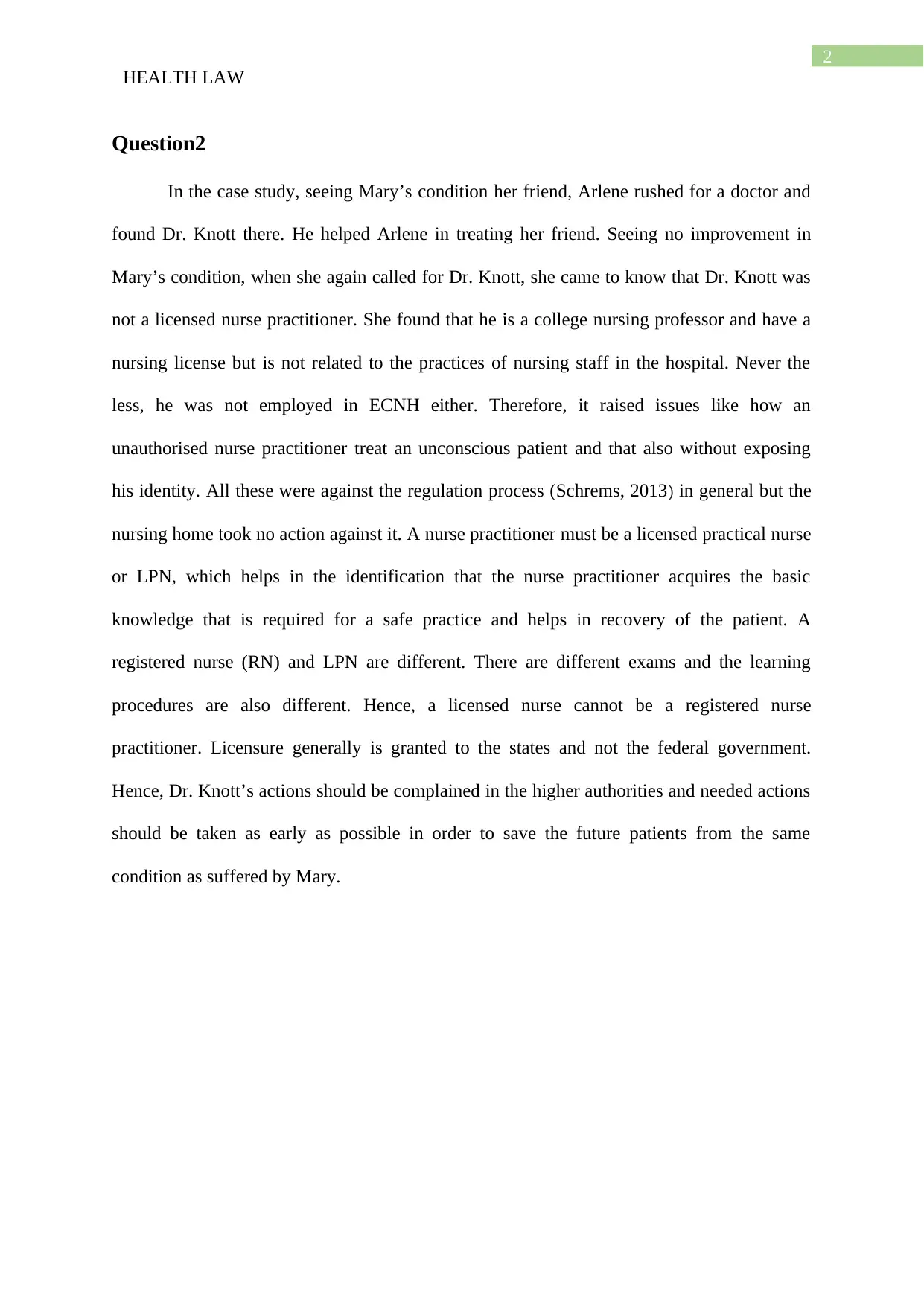
2
HEALTH LAW
Question2
In the case study, seeing Mary’s condition her friend, Arlene rushed for a doctor and
found Dr. Knott there. He helped Arlene in treating her friend. Seeing no improvement in
Mary’s condition, when she again called for Dr. Knott, she came to know that Dr. Knott was
not a licensed nurse practitioner. She found that he is a college nursing professor and have a
nursing license but is not related to the practices of nursing staff in the hospital. Never the
less, he was not employed in ECNH either. Therefore, it raised issues like how an
unauthorised nurse practitioner treat an unconscious patient and that also without exposing
his identity. All these were against the regulation process (Schrems, 2013) in general but the
nursing home took no action against it. A nurse practitioner must be a licensed practical nurse
or LPN, which helps in the identification that the nurse practitioner acquires the basic
knowledge that is required for a safe practice and helps in recovery of the patient. A
registered nurse (RN) and LPN are different. There are different exams and the learning
procedures are also different. Hence, a licensed nurse cannot be a registered nurse
practitioner. Licensure generally is granted to the states and not the federal government.
Hence, Dr. Knott’s actions should be complained in the higher authorities and needed actions
should be taken as early as possible in order to save the future patients from the same
condition as suffered by Mary.
HEALTH LAW
Question2
In the case study, seeing Mary’s condition her friend, Arlene rushed for a doctor and
found Dr. Knott there. He helped Arlene in treating her friend. Seeing no improvement in
Mary’s condition, when she again called for Dr. Knott, she came to know that Dr. Knott was
not a licensed nurse practitioner. She found that he is a college nursing professor and have a
nursing license but is not related to the practices of nursing staff in the hospital. Never the
less, he was not employed in ECNH either. Therefore, it raised issues like how an
unauthorised nurse practitioner treat an unconscious patient and that also without exposing
his identity. All these were against the regulation process (Schrems, 2013) in general but the
nursing home took no action against it. A nurse practitioner must be a licensed practical nurse
or LPN, which helps in the identification that the nurse practitioner acquires the basic
knowledge that is required for a safe practice and helps in recovery of the patient. A
registered nurse (RN) and LPN are different. There are different exams and the learning
procedures are also different. Hence, a licensed nurse cannot be a registered nurse
practitioner. Licensure generally is granted to the states and not the federal government.
Hence, Dr. Knott’s actions should be complained in the higher authorities and needed actions
should be taken as early as possible in order to save the future patients from the same
condition as suffered by Mary.
⊘ This is a preview!⊘
Do you want full access?
Subscribe today to unlock all pages.

Trusted by 1+ million students worldwide
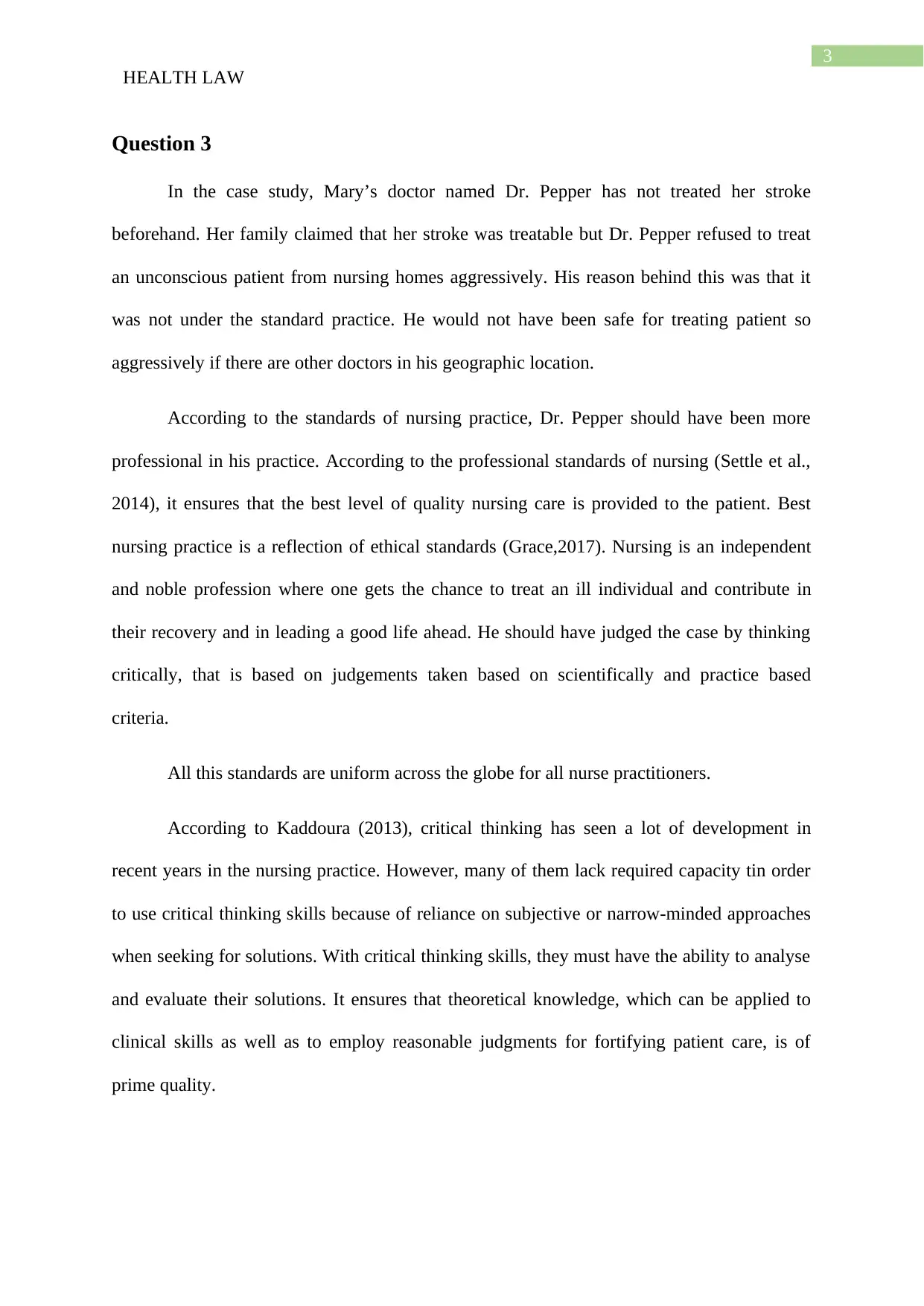
3
HEALTH LAW
Question 3
In the case study, Mary’s doctor named Dr. Pepper has not treated her stroke
beforehand. Her family claimed that her stroke was treatable but Dr. Pepper refused to treat
an unconscious patient from nursing homes aggressively. His reason behind this was that it
was not under the standard practice. He would not have been safe for treating patient so
aggressively if there are other doctors in his geographic location.
According to the standards of nursing practice, Dr. Pepper should have been more
professional in his practice. According to the professional standards of nursing (Settle et al.,
2014), it ensures that the best level of quality nursing care is provided to the patient. Best
nursing practice is a reflection of ethical standards (Grace,2017). Nursing is an independent
and noble profession where one gets the chance to treat an ill individual and contribute in
their recovery and in leading a good life ahead. He should have judged the case by thinking
critically, that is based on judgements taken based on scientifically and practice based
criteria.
All this standards are uniform across the globe for all nurse practitioners.
According to Kaddoura (2013), critical thinking has seen a lot of development in
recent years in the nursing practice. However, many of them lack required capacity tin order
to use critical thinking skills because of reliance on subjective or narrow-minded approaches
when seeking for solutions. With critical thinking skills, they must have the ability to analyse
and evaluate their solutions. It ensures that theoretical knowledge, which can be applied to
clinical skills as well as to employ reasonable judgments for fortifying patient care, is of
prime quality.
HEALTH LAW
Question 3
In the case study, Mary’s doctor named Dr. Pepper has not treated her stroke
beforehand. Her family claimed that her stroke was treatable but Dr. Pepper refused to treat
an unconscious patient from nursing homes aggressively. His reason behind this was that it
was not under the standard practice. He would not have been safe for treating patient so
aggressively if there are other doctors in his geographic location.
According to the standards of nursing practice, Dr. Pepper should have been more
professional in his practice. According to the professional standards of nursing (Settle et al.,
2014), it ensures that the best level of quality nursing care is provided to the patient. Best
nursing practice is a reflection of ethical standards (Grace,2017). Nursing is an independent
and noble profession where one gets the chance to treat an ill individual and contribute in
their recovery and in leading a good life ahead. He should have judged the case by thinking
critically, that is based on judgements taken based on scientifically and practice based
criteria.
All this standards are uniform across the globe for all nurse practitioners.
According to Kaddoura (2013), critical thinking has seen a lot of development in
recent years in the nursing practice. However, many of them lack required capacity tin order
to use critical thinking skills because of reliance on subjective or narrow-minded approaches
when seeking for solutions. With critical thinking skills, they must have the ability to analyse
and evaluate their solutions. It ensures that theoretical knowledge, which can be applied to
clinical skills as well as to employ reasonable judgments for fortifying patient care, is of
prime quality.
Paraphrase This Document
Need a fresh take? Get an instant paraphrase of this document with our AI Paraphraser
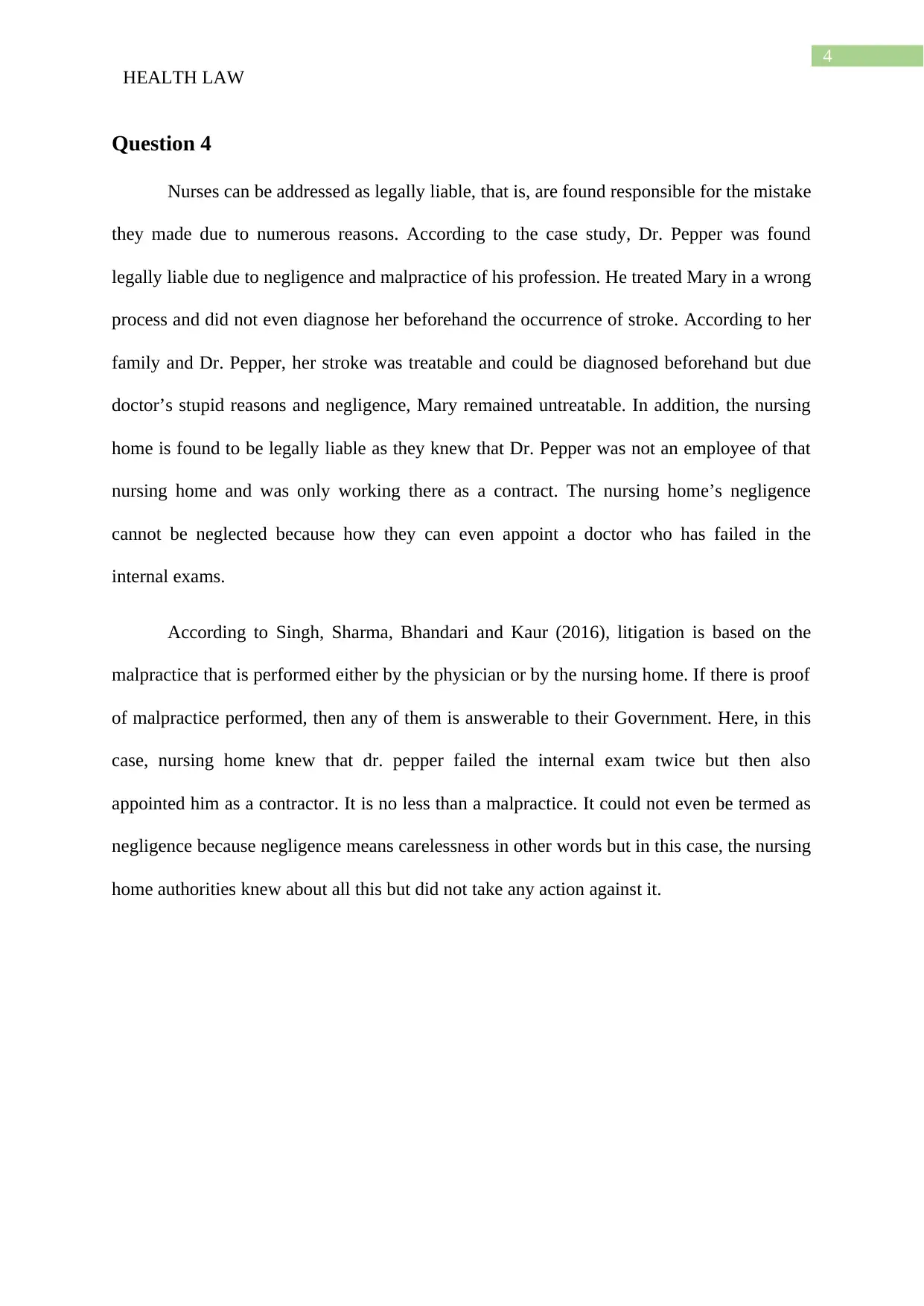
4
HEALTH LAW
Question 4
Nurses can be addressed as legally liable, that is, are found responsible for the mistake
they made due to numerous reasons. According to the case study, Dr. Pepper was found
legally liable due to negligence and malpractice of his profession. He treated Mary in a wrong
process and did not even diagnose her beforehand the occurrence of stroke. According to her
family and Dr. Pepper, her stroke was treatable and could be diagnosed beforehand but due
doctor’s stupid reasons and negligence, Mary remained untreatable. In addition, the nursing
home is found to be legally liable as they knew that Dr. Pepper was not an employee of that
nursing home and was only working there as a contract. The nursing home’s negligence
cannot be neglected because how they can even appoint a doctor who has failed in the
internal exams.
According to Singh, Sharma, Bhandari and Kaur (2016), litigation is based on the
malpractice that is performed either by the physician or by the nursing home. If there is proof
of malpractice performed, then any of them is answerable to their Government. Here, in this
case, nursing home knew that dr. pepper failed the internal exam twice but then also
appointed him as a contractor. It is no less than a malpractice. It could not even be termed as
negligence because negligence means carelessness in other words but in this case, the nursing
home authorities knew about all this but did not take any action against it.
HEALTH LAW
Question 4
Nurses can be addressed as legally liable, that is, are found responsible for the mistake
they made due to numerous reasons. According to the case study, Dr. Pepper was found
legally liable due to negligence and malpractice of his profession. He treated Mary in a wrong
process and did not even diagnose her beforehand the occurrence of stroke. According to her
family and Dr. Pepper, her stroke was treatable and could be diagnosed beforehand but due
doctor’s stupid reasons and negligence, Mary remained untreatable. In addition, the nursing
home is found to be legally liable as they knew that Dr. Pepper was not an employee of that
nursing home and was only working there as a contract. The nursing home’s negligence
cannot be neglected because how they can even appoint a doctor who has failed in the
internal exams.
According to Singh, Sharma, Bhandari and Kaur (2016), litigation is based on the
malpractice that is performed either by the physician or by the nursing home. If there is proof
of malpractice performed, then any of them is answerable to their Government. Here, in this
case, nursing home knew that dr. pepper failed the internal exam twice but then also
appointed him as a contractor. It is no less than a malpractice. It could not even be termed as
negligence because negligence means carelessness in other words but in this case, the nursing
home authorities knew about all this but did not take any action against it.
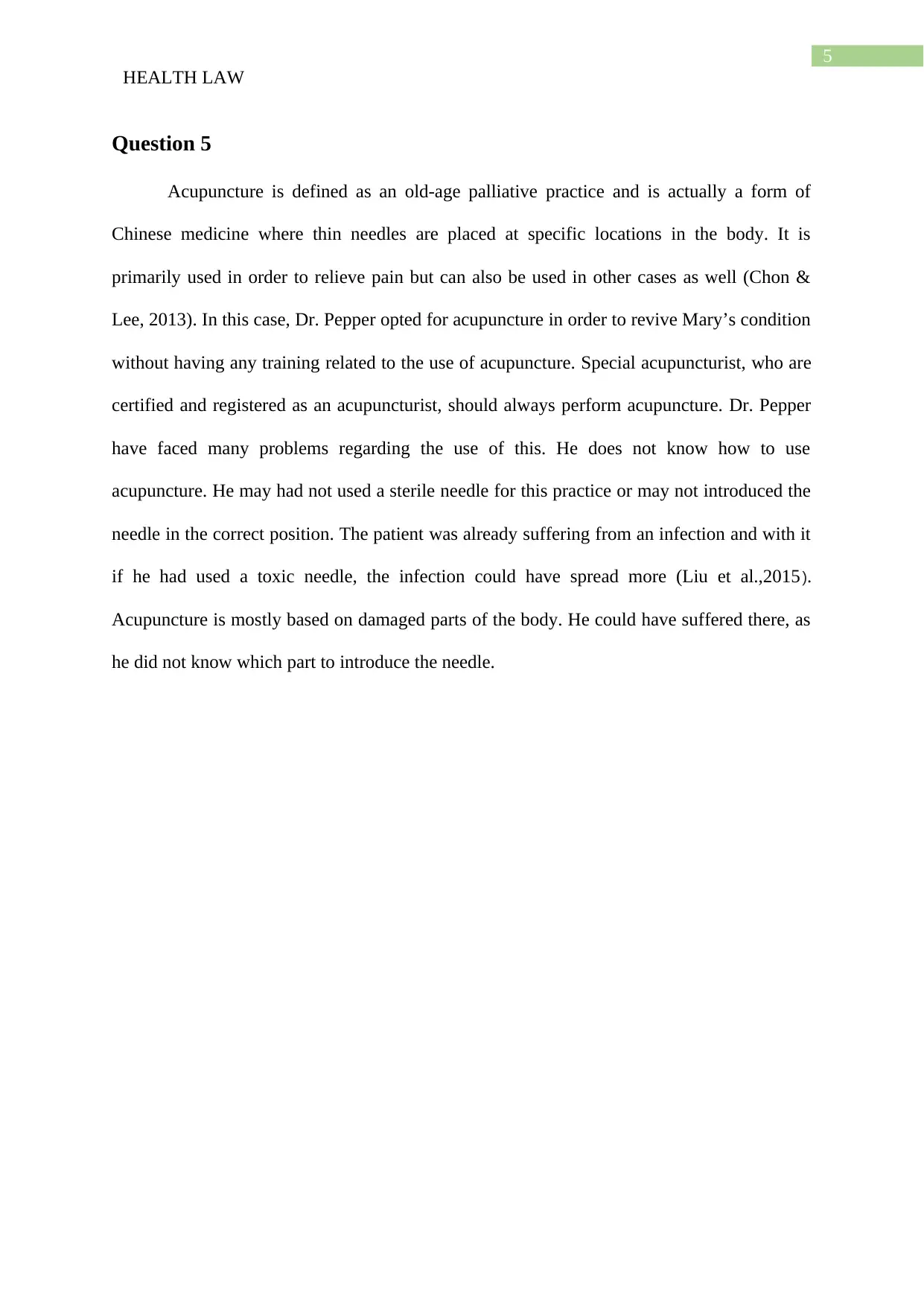
5
HEALTH LAW
Question 5
Acupuncture is defined as an old-age palliative practice and is actually a form of
Chinese medicine where thin needles are placed at specific locations in the body. It is
primarily used in order to relieve pain but can also be used in other cases as well (Chon &
Lee, 2013). In this case, Dr. Pepper opted for acupuncture in order to revive Mary’s condition
without having any training related to the use of acupuncture. Special acupuncturist, who are
certified and registered as an acupuncturist, should always perform acupuncture. Dr. Pepper
have faced many problems regarding the use of this. He does not know how to use
acupuncture. He may had not used a sterile needle for this practice or may not introduced the
needle in the correct position. The patient was already suffering from an infection and with it
if he had used a toxic needle, the infection could have spread more (Liu et al.,2015).
Acupuncture is mostly based on damaged parts of the body. He could have suffered there, as
he did not know which part to introduce the needle.
HEALTH LAW
Question 5
Acupuncture is defined as an old-age palliative practice and is actually a form of
Chinese medicine where thin needles are placed at specific locations in the body. It is
primarily used in order to relieve pain but can also be used in other cases as well (Chon &
Lee, 2013). In this case, Dr. Pepper opted for acupuncture in order to revive Mary’s condition
without having any training related to the use of acupuncture. Special acupuncturist, who are
certified and registered as an acupuncturist, should always perform acupuncture. Dr. Pepper
have faced many problems regarding the use of this. He does not know how to use
acupuncture. He may had not used a sterile needle for this practice or may not introduced the
needle in the correct position. The patient was already suffering from an infection and with it
if he had used a toxic needle, the infection could have spread more (Liu et al.,2015).
Acupuncture is mostly based on damaged parts of the body. He could have suffered there, as
he did not know which part to introduce the needle.
⊘ This is a preview!⊘
Do you want full access?
Subscribe today to unlock all pages.

Trusted by 1+ million students worldwide
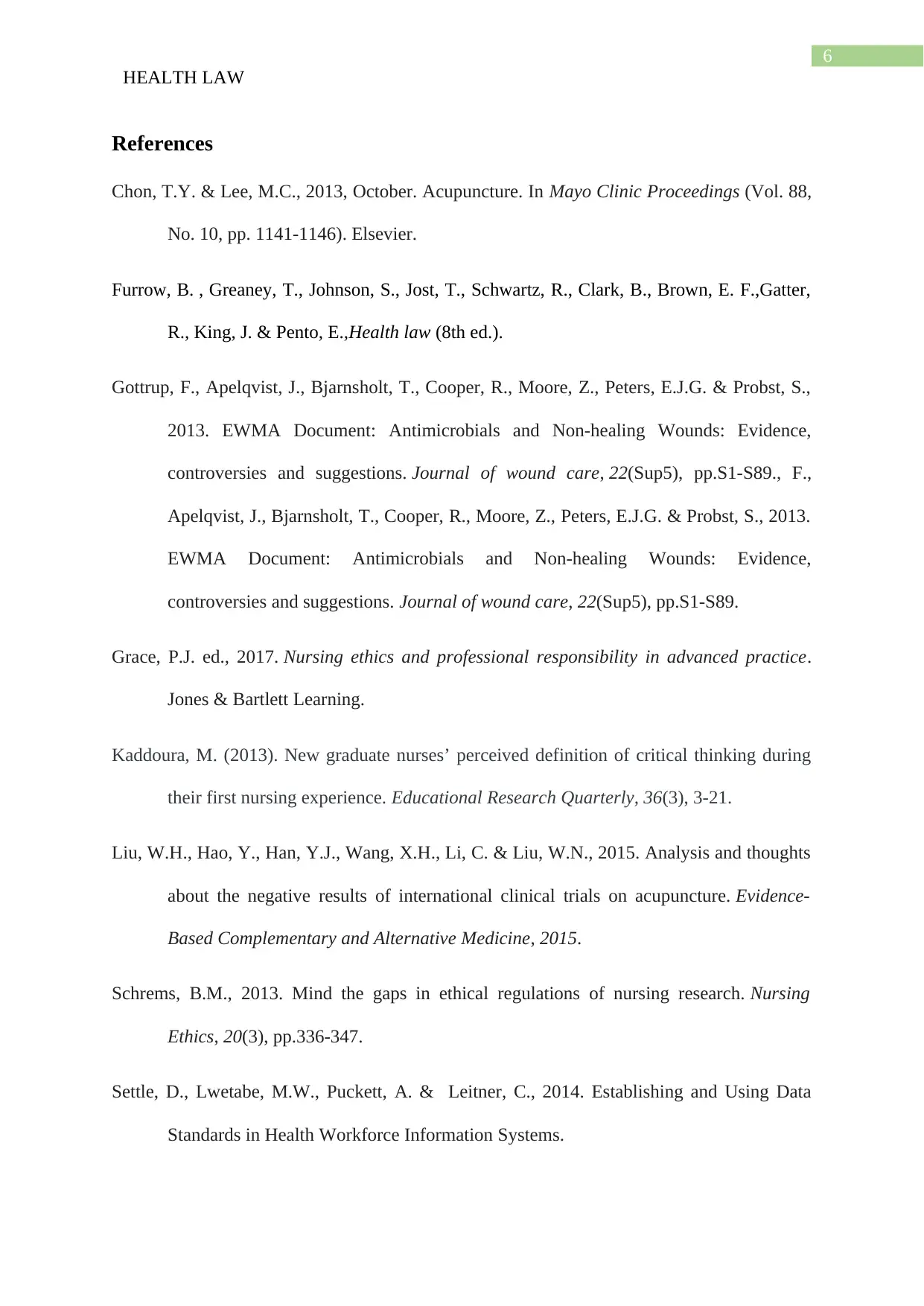
6
HEALTH LAW
References
Chon, T.Y. & Lee, M.C., 2013, October. Acupuncture. In Mayo Clinic Proceedings (Vol. 88,
No. 10, pp. 1141-1146). Elsevier.
Furrow, B. , Greaney, T., Johnson, S., Jost, T., Schwartz, R., Clark, B., Brown, E. F.,Gatter,
R., King, J. & Pento, E.,Health law (8th ed.).
Gottrup, F., Apelqvist, J., Bjarnsholt, T., Cooper, R., Moore, Z., Peters, E.J.G. & Probst, S.,
2013. EWMA Document: Antimicrobials and Non-healing Wounds: Evidence,
controversies and suggestions. Journal of wound care, 22(Sup5), pp.S1-S89., F.,
Apelqvist, J., Bjarnsholt, T., Cooper, R., Moore, Z., Peters, E.J.G. & Probst, S., 2013.
EWMA Document: Antimicrobials and Non-healing Wounds: Evidence,
controversies and suggestions. Journal of wound care, 22(Sup5), pp.S1-S89.
Grace, P.J. ed., 2017. Nursing ethics and professional responsibility in advanced practice.
Jones & Bartlett Learning.
Kaddoura, M. (2013). New graduate nurses’ perceived definition of critical thinking during
their first nursing experience. Educational Research Quarterly, 36(3), 3-21.
Liu, W.H., Hao, Y., Han, Y.J., Wang, X.H., Li, C. & Liu, W.N., 2015. Analysis and thoughts
about the negative results of international clinical trials on acupuncture. Evidence-
Based Complementary and Alternative Medicine, 2015.
Schrems, B.M., 2013. Mind the gaps in ethical regulations of nursing research. Nursing
Ethics, 20(3), pp.336-347.
Settle, D., Lwetabe, M.W., Puckett, A. & Leitner, C., 2014. Establishing and Using Data
Standards in Health Workforce Information Systems.
HEALTH LAW
References
Chon, T.Y. & Lee, M.C., 2013, October. Acupuncture. In Mayo Clinic Proceedings (Vol. 88,
No. 10, pp. 1141-1146). Elsevier.
Furrow, B. , Greaney, T., Johnson, S., Jost, T., Schwartz, R., Clark, B., Brown, E. F.,Gatter,
R., King, J. & Pento, E.,Health law (8th ed.).
Gottrup, F., Apelqvist, J., Bjarnsholt, T., Cooper, R., Moore, Z., Peters, E.J.G. & Probst, S.,
2013. EWMA Document: Antimicrobials and Non-healing Wounds: Evidence,
controversies and suggestions. Journal of wound care, 22(Sup5), pp.S1-S89., F.,
Apelqvist, J., Bjarnsholt, T., Cooper, R., Moore, Z., Peters, E.J.G. & Probst, S., 2013.
EWMA Document: Antimicrobials and Non-healing Wounds: Evidence,
controversies and suggestions. Journal of wound care, 22(Sup5), pp.S1-S89.
Grace, P.J. ed., 2017. Nursing ethics and professional responsibility in advanced practice.
Jones & Bartlett Learning.
Kaddoura, M. (2013). New graduate nurses’ perceived definition of critical thinking during
their first nursing experience. Educational Research Quarterly, 36(3), 3-21.
Liu, W.H., Hao, Y., Han, Y.J., Wang, X.H., Li, C. & Liu, W.N., 2015. Analysis and thoughts
about the negative results of international clinical trials on acupuncture. Evidence-
Based Complementary and Alternative Medicine, 2015.
Schrems, B.M., 2013. Mind the gaps in ethical regulations of nursing research. Nursing
Ethics, 20(3), pp.336-347.
Settle, D., Lwetabe, M.W., Puckett, A. & Leitner, C., 2014. Establishing and Using Data
Standards in Health Workforce Information Systems.
Paraphrase This Document
Need a fresh take? Get an instant paraphrase of this document with our AI Paraphraser
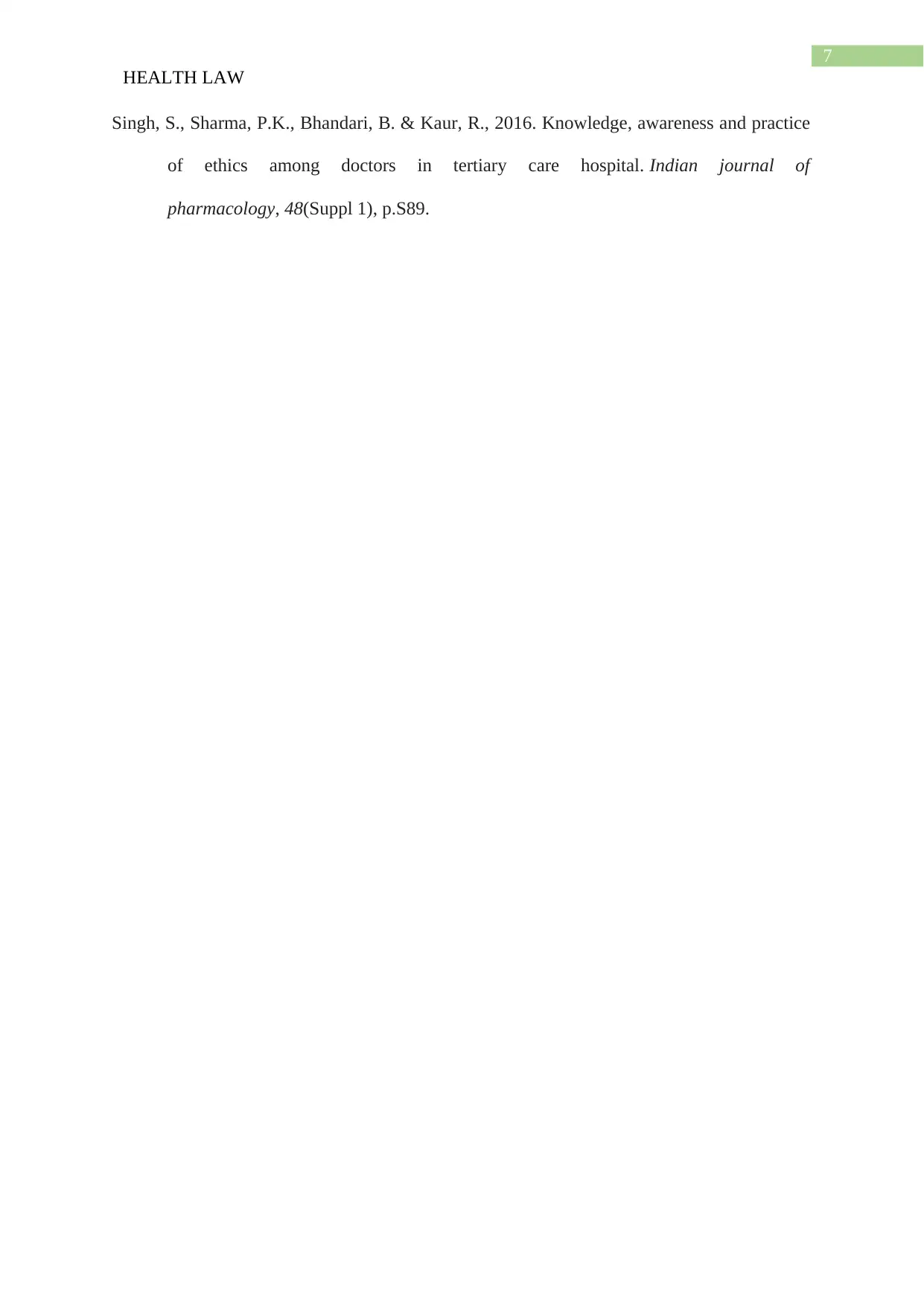
7
HEALTH LAW
Singh, S., Sharma, P.K., Bhandari, B. & Kaur, R., 2016. Knowledge, awareness and practice
of ethics among doctors in tertiary care hospital. Indian journal of
pharmacology, 48(Suppl 1), p.S89.
HEALTH LAW
Singh, S., Sharma, P.K., Bhandari, B. & Kaur, R., 2016. Knowledge, awareness and practice
of ethics among doctors in tertiary care hospital. Indian journal of
pharmacology, 48(Suppl 1), p.S89.
1 out of 8
Related Documents
Your All-in-One AI-Powered Toolkit for Academic Success.
+13062052269
info@desklib.com
Available 24*7 on WhatsApp / Email
![[object Object]](/_next/static/media/star-bottom.7253800d.svg)
Unlock your academic potential
Copyright © 2020–2025 A2Z Services. All Rights Reserved. Developed and managed by ZUCOL.





